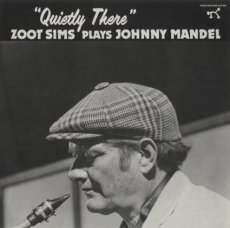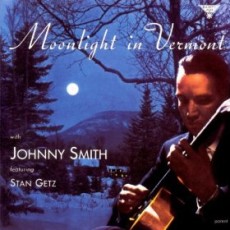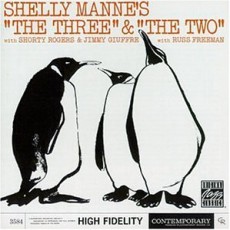
Daily Dose Of Jazz…
Alvin Gilbert Cohn was born on November 24, 1925 in Brooklyn, New York. He was initially known in the 1940s for playing in Woody Herman’s Second Herd as one of the Four Brothers, along with Zoot Sims, Stan Getz and Serge Chaloff. He contributed arrangements to the band until he left and formed a long association co-leading a quintet with Zoot while also playing with a variety of other musicians.
The partnership that began in 1956 lasted until Sims’ death and yielded one of their best albums on Mercury Records called You ‘n’ Me in 1960 and also backed Jack Kerouac on a few of his recordings. An accomplished arranger, Cohn worked Broadway arranging for such shows as Raisin’ and Sophisticated Ladies, worked with Linda Rondstadt, and appeared with Elvis Presley at Madison Square Garden.
Al Cohn, a tenor saxophonist, who had a reputation as a lyrical flowing soloist, passed away in Stroudsburg, Pennsylvania on February 15, 1988.
More Posts: saxophone

Daily Dose Of Jazz…
John Haley “Zoot” Sims was born on October 29, 1925 in Inglewood, California to vaudeville parents. Growing up in a performing family he learned to play both drums and clarinet at an early age along with steps taught him by his hoofer father.
Learning to play saxophone he followed in the footsteps of Lester Young, developing into an innovative saxophonist. Always fond of the higher register of the tenor sax, Sims was considered one of the strongest swingers in the field by his peers.
By the ‘50s and into the ‘60s Zoot had a long and successful partnership as co-leader of a quintet with tenor saxophonist Al Cohn, recording under the name of al & Zoot and a favorite at The Half Note club in New York. He added alto and soprano saxophones over the course of his career playing with renowned bands such as Benny Goodman, Artie Shaw, Stan Kenton and Buddy Rich. Zoot also play with Gerry Mulligan and later with Mulligan’s Concert Jazz Band.
During this period he recorded a series of albums for Norman Granz on his Pablo Records label and played on a few of Jack Kerouac’s recordings. However, it was early in his career that he acquired his nicknamed “Zoot” while working with the Kenny Baker band in California and was later appropriated for the sax-playing Muppet.
Zoot Sims, tenor and soprano saxophonist passed away in New York City on March 23, 1985.
More Posts: saxophone

Daily Dose Of Jazz…
Johnny Smith was born John Henry Smith on June 25, 1922 in Birmingham, Alabama but his family moved north during the Depression living in several cities before their final destination ending in Portland, Maine.
Smith taught himself to play guitar in pawnshops, which let him play in exchange for keeping the guitars in tune. At thirteen years of age he was teaching others to play the guitar. He got his first guitar after one of his students bought a new guitar and gave him his old guitar becoming the first guitar Smith owned.
Dropping out of high school, Johnny joined a local hillbilly band, Uncle Lem and the Mountain Boys, and travelled around Maine earning four dollars a night. His interest in jazz peaked after hearing jazz bands on the radio, started practicing playing jazz, left The Mountain Boys at eighteen and founded a jazz trio called The Airport Boys.
Equally at home playing Birdland or sight-reading scores in the orchestral pit of the New York Philharmonic and was one of the most versatile guitarists of the 1950s. He recorded for Roost Records, with his most critically acclaimed Moonlight In Vermont was named one of Down Beat magazine’s top jazz albums in 1952. His most famous musical composition is the tune “Walk Don’t Run” in 1955. Johnny Smith stepped out of the public eye/ear in the 1960s, having moved to Colorado in 1958 to teach and run a music store and to raise his daughter after the death of his second wife. The cool jazz and mainstream guitarist who actively participated in the jazz scene from 1935 to 1960 passed away on June 11, 2013.
More Posts: guitar

Daily Dose Of Jazz…
Shelly Manne was born Sheldon Manne in New York City on June 11, 1920. His father and uncles were drummers, he got tips from drummer Billy Gladstone as a teenager and soon he rapidly developed his style in the 52nd Street clubs in the late 30s and 40s. He got his first professional job with the Bobby Byrne Orchestra and was soon recording with Coleman Hawkins, Charlie Shavers, Don Byas, Duke Ellington, Johnny Hodges, Harry Carney and Rex Stewart.
Manne rose to stardom when he became part of the bands of Woody Herman and Stan Kenton in the late 1940s and early 1950s, winning awards and developing a following at a time when jazz was the most popular music in the United States. When the bebop movement began to change jazz in the 1940s, Manne loved it and adapted to the style rapidly, performing with Dizzy Gillespie, Charlie Parker, Flip Phillips, Charlie Ventura, Lennie Tristano and Lee Konitz.
In the early 1950s, Manne left New York, settled permanently on a ranch outside Los Angeles, where he and his wife raised horses. This began his important role in the West Coast school of jazz, performing on the Los Angeles jazz scene with Shorty Rogers, Hampton Hawes, Red Mitchell, Art Pepper, Russ Freeman, Frank Rossolino, Chet Baker, Leroy Vinnegar and many others.
Shelly led a number of small groups that recorded under his name and leadership, recording his now famous live Black Hawk sessions and for Contemporary Records. He played in styles of Dixieland, swing, bebop, avant-garde jazz and fusion, as well as contributing to the musical background of hundreds of Hollywood films and television programs, collaborating with Henry Mancini on such films as Breakfast At Tiffany’s, Hatari and The Pink Panther and tv shows like Peter Gunn and Mr. Lucky.
Shelly Manne passed away of a heart attack on September 26, 1984 shortly before the popular revival of interest in jazz had gained momentum.
More Posts: drums

Daily Dose Of Jazz…
Russell Donald Freeman was born on May 28, 1926 in Chicago, Illinois. He was initially classically trained, but later turned toward jazz of a largely bop style. His reputation as a jazz pianist grew in the 1940s when he worked with Art Pepper, Shorty Rogers and Chet Baker. Among his best work is his extensive collaboration with Shelly Manne, especially in the 1950s and 1960s.
Freeman wrote “The Wind” with original lyrics by Jerry Gladstone and was performed as an instrumental piece during the 1950s and 1960s by the likes of Chet Baker, Leo Wright and Stan Getz as well as sung by vocalist June Christy. Russ’s piano is featured on the 1954 recording of “The Wind,” which has since become a jazz standard, for the album Chet Baker With Strings and Deep I A Dream: The Ultimate Chet Baker Collection, the latter he is featured on seven cuts. In 1991, Mariah Carey wrote her own lyrics to Freeman’s “The Wind” for her album Emotions.
Russ Freeman, bebop and cool jazz pianist, remained busy in music throughout his life, transitioning from jazz pianist to film scoring and composition before his death on June 27, 2002 in Las Vegas, Nevada.
More Posts: piano


